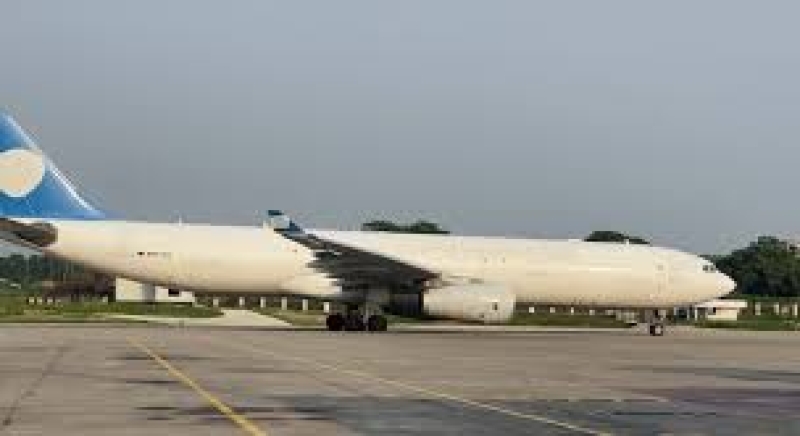- DMP issues 7 traffic directives for Osman Hadi’s Janaza |
- Vested quarter fuelling chaos to impose new fascism: Fakhrul |
- Hadi’s namaz-e-janaza at 2:30pm Saturday |
- Jashore’s Gadkhali blooms with hope; flowers may fetch Tk4 bn |
- Dhaka’s air quality 6th worst in the world this morning |
Bangladesh’s First Freighter Flight Takes Off from Sylhet

Marking a milestone in the country's export logistics, Bangladesh’s first-ever dedicated freighter flight departed from Sylhet’s Osmani International Airport on Sunday evening, amidst a ceremonial water cannon salute.
The chartered Airbus A330-300 freighter, operated by Galistair Aviation, carried 60 tonnes of readymade garments (RMG) to Zaragoza, Spain, via Dubai. The flight comes in response to India’s recent suspension of third-country transshipment through its airports—a move that disrupted Bangladesh’s garment exports.
Biman Bangladesh Airlines is handling ground operations for the new cargo route.
“Initiating this cargo operation enhances our capacity and addresses the export disruption caused by India’s restrictions,” said Commerce and Civil Aviation Adviser Sk. Bashir Uddin, who inaugurated the service. “The government is working to reduce cargo costs and ensure competitive alternatives to Indian transshipment routes.”
Uddin also noted that efforts are underway to revise civil aviation and ground-handling tariffs to make air cargo services more affordable for exporters.
Bangladesh’s Ambassador to Mexico, M. Mushfiqul Fazal Ansarey, and Civil Aviation and Tourism Secretary Nasreen Jahan also spoke at the event. Ansarey emphasized the importance of self-reliance in trade logistics: “We are no longer dependent on others. From Sylhet, our goods will now reach the global market directly.”
Air Vice Marshal Md Monjur Kabir Bhuiyan, Chairman of the Civil Aviation Authority of Bangladesh (CAAB), presided over the ceremony and announced plans to expand cargo operations. “We will soon launch cargo flights from Chattogram and begin operations from Cox’s Bazar in June,” he said. “Two weekly freighter flights will initially operate from Sylhet, with frequency increasing based on demand.”
CAAB and Biman have also increased staffing at Hazrat Shahjalal International Airport’s (HSIA) cargo terminal in preparation for the Third Terminal’s opening, which will significantly boost capacity.
“Our infrastructure is evolving to handle two to three times more cargo volume. Sylhet’s newly upgraded terminal is already equipped with substantial handling capacity,” Bhuiyan added.
The event was attended by key cargo handlers and local business leaders, encouraging the Sylhet business community to take advantage of the new export channel.
The HSIA Third Terminal, featuring a 36,000-square-metre dedicated cargo zone, is expected to raise Bangladesh’s air cargo capacity from 200,000 to 546,000 tonnes annually.
India’s abrupt withdrawal from a four-year arrangement that allowed Bangladeshi goods to transit via airports such as Kolkata and Delhi has significantly affected exporters. The Bangladesh Freight Forwarders Association (BAFFA) reported that around 600 tonnes—or 18 percent—of weekly garment air exports were routed through India.
Currently, Bangladesh exports about 3,400 tonnes of garments by air each week. HSIA, originally built to handle 300 tonnes per day, often processes over 1,200 tonnes during peak periods. Major airlines like Emirates, Cathay Pacific, Qatar Airways, Turkish Airlines, and Ethiopian Airlines operate dedicated cargo services from HSIA.

